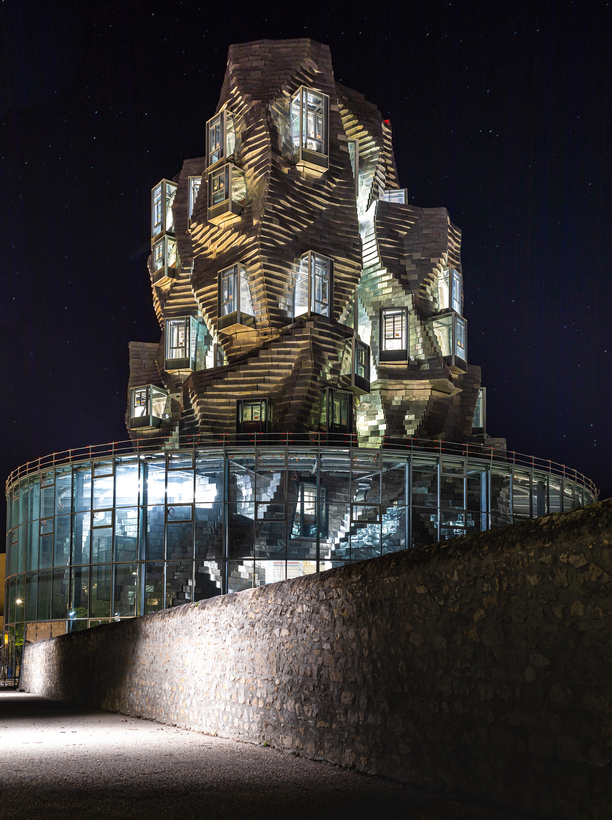The architect Frank Gehry first grabbed the public’s attention in 1978, when he radically remodeled his own home in Santa Monica. The formerly humble suburban bungalow looked like a cartoon explosion in a lumberyard. It had a joyfully blowsy spontaneity, like a Rauschenberg “combine” you could live in. “That’s the edge I’m after,” Gehry has said of his designs. “For people to see what I want them to see, but for them to not be quite sure if it was designed or if it just happened.” As in The Wizard of Oz, there’s a man up to something behind the curtain.
Gehry’s newest project opens to the public today. It’s a gravity-defying, pixelated swirl of stainless-steel blocks for the Luma Foundation, located in a town that Vincent van Gogh once called home—Arles, France. The nine-story tower is the centerpiece of Luma’s Parc des Ateliers, an interdisciplinary-arts park re-purposed from a 19th-century railway yard just outside the old city’s walls. The site’s weighty limestone industrial sheds have already been converted to galleries and performance spaces. Gehry’s work joins them as an arts study center.
The money shot for the Luma tower has splashed across the Internet: we see a brash, vertical jumble of stepped metal and mirror glass that seems to survey the historic city through its goggle-eyed windows. During the course of the day, shattered reflections of the sky’s changing light and color move across the building—you can imagine it writhing like some sort of shape-shifting creature. As the light fades toward evening, “you get the Starry Night sky color,” Gehry explains. “The light is there and I made it possible to see it the way Van Gogh saw it.” In fact, when approached from the town, the Luma tower commands the street like Van Gogh’s 21st-century revenge coming to get you.

Yet, with all its bravado, the building is sensitive to its immediate surroundings. It is sited out of view from the tangle of historic streets that Van Gogh once walked, and it can’t be seen from the nearby Roman amphitheaters or ancient necropolis in Arles’s World Heritage Site.
I prefer the other side of the building—which faces away from town into Luma’s park and beyond—where Gehry unexpectedly parts the tower’s roiling metal-and-glass curtain to expose two monumental limestone service shafts that rise to the building’s full height. It’s here that the architect reveals the scope of the design game he aims to play.
Arles is a low-lying town sitting on an agricultural plain that’s as flat as a tabletop. From distant farm fields, it’s a scramble of rooftops on the horizon, punctuated by church towers. As you back away from the Luma tower on the park side, then through the inevitable suburban clutter and into farmland, something special happens. The character of the building changes. The massive shafts tightly bind Gehry’s composition to the rest of the site—those limestone industrial sheds that house the galleries and performance spaces—while the cascading metal and glass that peek around the shafts appear surprisingly delicate, ethereal. This asymmetry is deeply satisfying—today’s computer-driven parametric design sidling up to the stone-on-stone architecture of the past.
For art pilgrims from nearby Aix-en-Provence, the first long view is a mile away, presented as they leave the N113 expressway. From that point, Gehry’s stone shafts mimic Arles’s historic church towers while the reflective surfaces melt into the sky.
The Luma tower plays one role from the street, another from the park, and a third from a distance. It’s subtle. It seems inevitable. It isn’t. —Lewis Jacobsen


 Discover
Discover